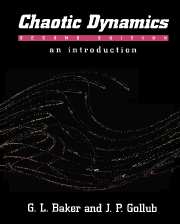Book contents
- Frontmatter
- Contents
- Preface
- Acknowledgments
- CHAPTER ONE Introduction
- CHAPTER TWO Some helpful tools
- CHAPTER THREE Visualization of the pendulum's dynamics
- CHAPTER FOUR Toward an understanding of chaos
- CHAPTER FIVE The characterization of chaotic attractors
- CHAPTER SIX Experimental characterization, prediction, and modification of chaotic states
- CHAPTER SEVEN Chaos broadly applied
- Further reading
- Appendix A Numerical integration – Runge–Kutta method
- Appendix B Computer program listings
- Appendix C Solutions to selected problems
- References
- Index
- Diskette order information
CHAPTER SIX - Experimental characterization, prediction, and modification of chaotic states
Published online by Cambridge University Press: 05 June 2012
- Frontmatter
- Contents
- Preface
- Acknowledgments
- CHAPTER ONE Introduction
- CHAPTER TWO Some helpful tools
- CHAPTER THREE Visualization of the pendulum's dynamics
- CHAPTER FOUR Toward an understanding of chaos
- CHAPTER FIVE The characterization of chaotic attractors
- CHAPTER SIX Experimental characterization, prediction, and modification of chaotic states
- CHAPTER SEVEN Chaos broadly applied
- Further reading
- Appendix A Numerical integration – Runge–Kutta method
- Appendix B Computer program listings
- Appendix C Solutions to selected problems
- References
- Index
- Diskette order information
Summary
Chaotic states occur widely in natural phenomena, but closed form mathematical models are rarely available. This situation leads to a number of related problems that bear on the use of experimental data. First, how is it possible to tell whether a set of apparently noisy data in fact arises from chaotic dynamics? Second, how can chaotic data be used to make short-term predictions or forecasts? Finally, how can experimental data be used to influence and control nonlinear systems? We address these questions in the present chapter.
Characterization of chaotic states
In this section, we consider the use of experimental data to test for the existence of chaos, to reconstruct the chaotic attractor if it exists, and to characterize its structure quantitatively.
One rarely has complete information about all of the degrees of freedom in a complex dynamical system. For example, in a chaotic fluid system, this information would include the velocity of the fluid at many different positions as a function of time. Even for the pendulum, a complete specification would seem to require measurement of three distinct time-dependent quantities (the angle, the angular velocity, and the phase of the forcing function).
Although this information can easily be obtained for a pendulum, it is more informative to use the pendulum to learn how to handle situations where a fuller description is unavailable. It is frequently possible to learn a considerable amount from a single time series, a list of successive values of one dynamical quantity.
Information
- Type
- Chapter
- Information
- Chaotic DynamicsAn Introduction, pp. 133 - 165Publisher: Cambridge University PressPrint publication year: 1996
Accessibility standard: Unknown
Why this information is here
This section outlines the accessibility features of this content - including support for screen readers, full keyboard navigation and high-contrast display options. This may not be relevant for you.Accessibility Information
- 1
- Cited by
